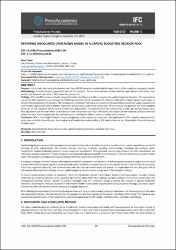| dc.contributor.author | Teker, Suat | en_US |
| dc.date.accessioned | 2023-02-03T10:11:58Z | |
| dc.date.available | 2023-02-03T10:11:58Z | |
| dc.date.issued | 2020-12-31 | |
| dc.identifier.citation | Teker, S. (2020). Revisiting discounted cash flows model as a capital budgeting decision tool. PressAcademia Procedia, 12(1), 60-63. doi:10.17261/Pressacademia.2020.1349 | en_US |
| dc.identifier.issn | 2459-0762 | en_US |
| dc.identifier.uri | https://hdl.handle.net/11729/5339 | |
| dc.identifier.uri | http://dx.doi.org/10.17261/Pressacademia.2020.1349 | |
| dc.description.abstract | Purpose- In thisstudy, the classical discounted cash flows (DCDF) model is revisited and the input factors of the model are analysed in details. Methodology- A model analysis approach is used in this research. The fundamental assumptions and the input factors (cash flows, time period, risk, discount rate, etc.) of DCF model are questioned. Findings- NPV and IRR are two methods using discounted cash flows and oftenly applied for capital budgeting decisions. The assumptions used in the DCF analysis are very strong and not fitting well in the reality of practical life. Economic life of the project may be much longer or shorter than projected in the analysis. The computation of discount rate bases on subjective interpretations (weights of capital components, cost of debt, opportunity cost of equity). Estimation of cash flows is the most critical input of the analysis but generally the least weighted factor (CF or FCF, inclusion of only relevant cash flows, depreciation and interest expenses, installments, credit sales and purchases, etc.). Risk adjustment can be made either on the discount rate or expected cash flows. Moreover, the analysis of international capital investments makes the issue more complicated. Also, the inclusion of real options adds an economic value to the analysis. Conclusion- DCF is not straight forward a capital budgeting model anyone can easily use. The application of DCF requires expertise and a picky view on details. Nevertheless, the acceptance of capital investments utilizing DCF method can not be independent of overall company strategic goals. | en_US |
| dc.language.iso | en | en_US |
| dc.publisher | PressAcademia | en_US |
| dc.relation.ispartof | PressAcademia Procedia | en_US |
| dc.rights | info:eu-repo/semantics/openAccess | en_US |
| dc.subject | Discounted cash flows | en_US |
| dc.subject | Discount rate | en_US |
| dc.subject | Capital budgeting decisions | en_US |
| dc.subject | Expected cash flows | en_US |
| dc.title | Revisiting discounted cash flows model as a capital budgeting decision tool | en_US |
| dc.type | Article | en_US |
| dc.description.version | Publisher's Version | en_US |
| dc.department | Işık Üniversitesi, İktisadi ve İdari Bilimler Fakültesi, Ekonomi Bölümü | en_US |
| dc.department | Işık University, Faculty of Economics and Administrative Sciences, Department of Economics | en_US |
| dc.authorid | 0000-0002-7981-3121 | |
| dc.authorid | 0000-0002-7981-3121 | en_US |
| dc.identifier.volume | 12 | |
| dc.identifier.issue | 1 | |
| dc.identifier.startpage | 60 | |
| dc.identifier.endpage | 63 | |
| dc.peerreviewed | Yes | en_US |
| dc.publicationstatus | Published | en_US |
| dc.relation.publicationcategory | Makale - Ulusal Hakemli Dergi - Kurum Öğretim Elemanı | en_US |
| dc.institutionauthor | Teker, Suat | en_US |


















